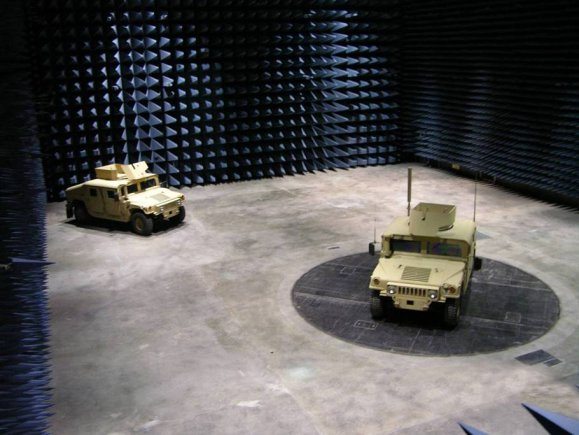The U.S. Army Research Laboratory, Survivability/Lethality Analysis Directorate’s state-of-the-art Electromagnetic Vulnerability Assessment Facility here is used to conduct experiments that address the electromagnetic vulnerability requirements of the U.S. Army Weapon and Communication-Electronics Systems.
Electromagnetic vulnerability is the characteristics of a system that cause it to suffer a definite degradation (incapability to perform the designated mission) as a result of having been subjected to a certain level of electromagnetic environmental effects, also called EMV.
The Electromagnetic Vulnerability Assessment Facility, or EMVAF, is used to sustain Army Research Laboratory’s, or ARL’s, ongoing mission to evaluate Army weapon systems’ survivability against the full spectrum of electromagnetic energy threats on the battlefield and in operations other than war. This includes the means to determine weapon systems’ survivability against radio-frequency directed energy weapons, electronic warfare jamming and unintentional interference.
The EMVAF is a secure electromagnetic spectrum research facility that houses two double-shielded anechoic chambers, each of which enable precise controlled measurements. The main shielded anechoic chamber is 100 ft. x 70 ft. x 40 ft., and has a turntable capable of supporting 100-ton test vehicles. It is the largest of its type in the Army.
An anechoic chamber is designed to reduce all spurious radio frequency, or RF, energy to a minimum. In so doing, experiments can be performed in an RF environment with the minimum number of variables making the RF engineers analysis faster and more definitive.
At the EMVAF, two methods of reducing the spurious RF energy are the 100-decibel isolation that each layer of the shielding system provides and the radar absorbing material, or RAM, ability to absorb RF energy that is generated within the chamber.
In simple terms, the RF shielding is the fully seam welded steel structure surrounding the chamber that includes RF tight doors. This is also known as a Faraday cage, which guarantees that RF energy generated outside the shield stays out of the chamber environment.
Likewise, RF energy that is generated inside the shield stays inside the chamber. The modern world RF environment is very noisy. Keeping the noisy world outside of the chamber reduces the number of accidental interference or variables for an experiment. Keeping the signals generated inside the chamber and within the chamber offers a level of security to a system developer depending on the classification of signals they may be generating.
The RAM that lines the inside of the chamber is designed to absorb the RF energy that is generated during an experiment. This is critical since each chamber is in essence a huge metal box, which would otherwise allow the RF to bounce off the walls and back to the item under investigation.
By absorbing the RF energy at the boundaries, the engineer can strictly control and thus identify what energy is specifically occurring between the item under investigation and the receive antenna in the chamber.
With the high level of control of the RF energy in the chamber, engineers can perform a wide range of RF tests within the chambers. These tests can include radiated emissions as well as radiated interference tests. In the first case, the engineer is looking at what the test item is radiating and in the second what RF energy will cause problems for the system.
The EMVAF, and more specifically the Survivability/Lethality Analysis Directorate, or SLAD, has available a wide range of personnel expertise that can be brought to bear on any given experiment. If a specific project at the EMVAF requires expertise in electronic warfare, computer network operations, counter-improvised explosive device, laser and optics or infrared, all can be supported with local expertise in the area.
If specific radio communications expertise is required that cannot be fulfilled locally, then experts within SLAD at Aberdeen Proving Ground, Md., can be brought in to support the requirement. In short, SLAD has the ability to supply the expertise required to make certain projects supported at the EMVAF receive the high quality data needed to move forward.
In addition to the chambers, the EMVAF includes control rooms, laboratory and office space. It is the Army’s premiere facility for performing controlled measurements for RF and microwave survivability/lethality/vulnerability of electronic systems.
Expertise in electronic warfare, counter IED, computer network operations, and modeling and simulation can all be brought in from local SLAD resources to meet specific requirements of a given customer. In so doing, the experiment design can be closely tailored to meet the exacting requirements of the given program.










